Active labor is part of the first stage of labor, and where parents spend the bulk of their time in the birthing process. Active labor happens when contractions become longer, stronger, and closer together and, if they haven’t already, when parents begin to make their way to the hospital.
Questions About Active Labor
Many parents have a lot of questions about active labor.
What are some signs that labor is nearing?
How long is active labor?
How many centimeters is active labor?
What can I do to cope through active labor?
How do I time contractions?
When do I go to the hospital?
These questions and much more are discussed in this blog post, which is one of a three part series called The Stages of Labor: How To and Helpful Tips. If you’re wanting to know how labor generally unfolds, you’ll definitely want to check it out.
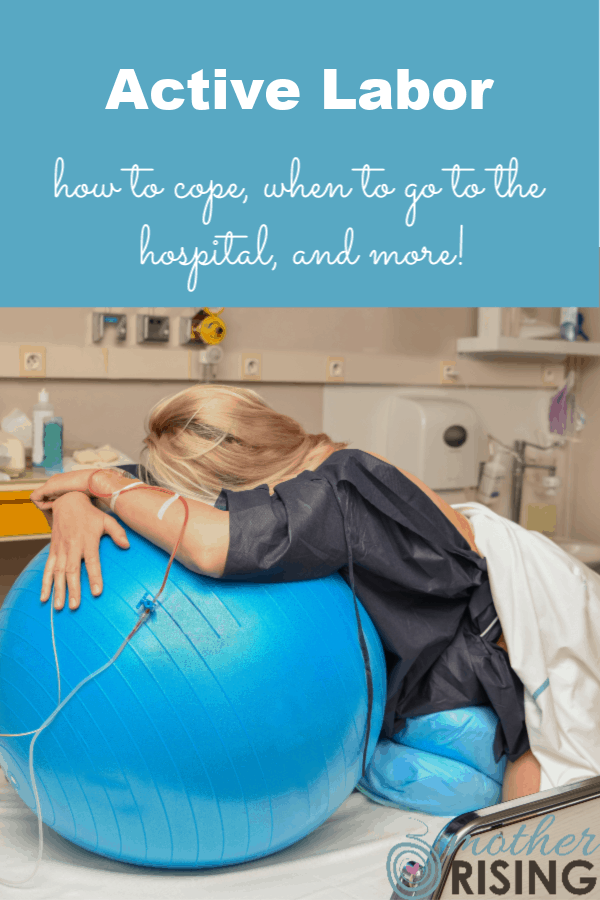
Signs of Active Labor
Just like early labor and transition, active labor is part of the first stage of labor. Active labor comes after early labor but before transition.
Contractions that…
- get longer, stronger and closer together
- have an average length of around 60 seconds
- are around 3-5 minutes apart. In early labor maybe they were more like 5-7 (or greater) minutes apart
- are timeable and predictable, whereas in early labor maybe they were every 5, then 7, then 4, then 10 minutes apart
- require intense focus and concentration.
- require the use of pain coping practices, such as breathing techniques, shower, tub, massage, etc.
- don’t space out, fizzle out or go away during a shower, bath, after a glass of water or rest.
Also, during active labor parents may notice…
- a need to settle in to the birth space, wherever that may be.
- feeling emotional, or unsure about what’s ahead and “if I can do it”
- bloody show, light pink spotting and/or mucusy discharge (head on over here to see what a mucus plug look like)
- cervical dilation. (Active labor is defined by contractions that have caused the cervix to at least dilate to 6 cm.)
- diarrhea
- vomiting
- feeling shaky, hot, and/or cold
- the amniotic sac or “water” breaks
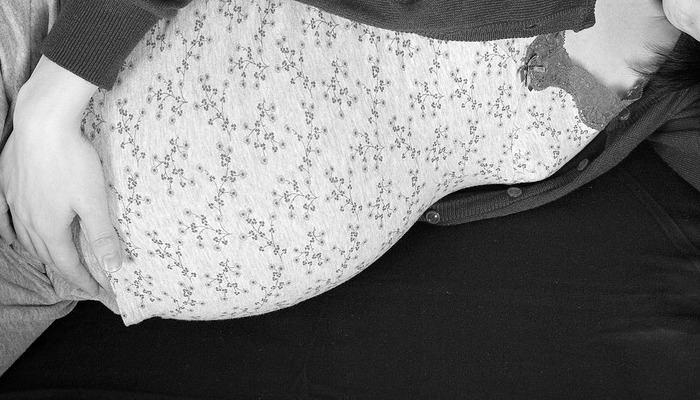
How Long is Active Labor?
On average, a first time mom’s labor is around 15-17 hours, however, many women experience labors longer or shorter than that, while still being in the range of normal. Everybody is different!
Active labor is typically longer than all the other parts of labor combined – early, transition, pushing, placenta, etc. Once parents move past active labor, things generally move rather quickly!
How Many Centimeters Is Active Labor?
Just as all women and pregnancies are different, it will take a different amount of time for each woman to arrive at 6 cm, the textbook definition of active labor.
Take heart, however, because once you hit 6 cm things typically start to go faster. You will spend most of your time getting to 6 cm. Usually.
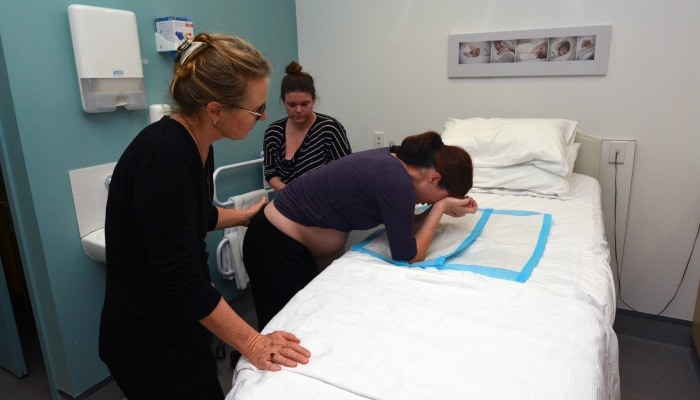
Birth Isn’t Linear
At this point, we need to interrupt our conversation about active labor to discuss a very important idea. Birth is not linear and birth math does not exist.
For example, say it took you 6 hours to get to 6 centimeters. Logically, you might thing that therefore it’ll take you 4 more hours to get to 10 cm aka stage 2 or the pushing stage.
STOP!
Birth math does not exist and birth is not linear. We do not simply walk from point a to point b to have a baby. So, therefore, any sort of calculating or future predictions about birth are pointless and a waste of time. (Often including cervical exams!)
Birth is a journey into the unknown. We can’t control or predict it. Birth is sometimes a journey of surrender and letting go.
Coping through this kind of journey can be quite frustrating, especially for the typical American that wants a lengthy birth plan and be in control of everything (I do this too!!). However, to have the best birth experience no matter what happens, it’s important to “be present” in THIS moment, instead of constantly looking ahead.
One of the most simple ways of being present in birth (and in life) is by noticing the breath – not changing it – but simply bringing the awareness to the breath. This is called breath awareness.
What Can I Do to Cope Through Active Labor?
In early labor, it was easier to walk and talk through contractions. For example, a woman could be in the grocery store and nobody may have known she was having early labor contractions. However, during active labor, things are much different.
In active labor, parents must do something to deal with the intensity of labor. During each contraction parents stop and actively cope because active labor demands all their focus and energy.
In between contractions, some parents may still feel like their normal selves, but as labor moves towards transition, this feeling eventually goes away. In early labor it may have been easy to answer questions from a spouse or think about what needs to be done before heading to the hospital, but in active labor the thinking mind slowly drifts away and is replaced by a more “in the moment” mindset I call labor land.
Many parents find the following ways of coping to be helpful as labor progresses on into active labor.
- Changing positions frequently
- Walking
- Swaying
- Forward leaning on partner, ball, or bed
- Squatting
- Sitting on the toilet
- Tub and/or shower
- Resting
- Rocking and swaying rhythmically
- Massage and counter pressure
- Birth Ball
- Moaning, humming, singing
- Music
- Aromatherapy
- Birth affirmations and other words of encouragement
- Eating and drinking freely

How Do I Time Contractions?
To find out how far apart contractions are, simply calculate the minutes between the start of one contraction to the start of the next.
Also, take note of how long each contraction is, as that’s a helpful indicator of how labor is progressing.
My favorite way to time contractions is with a contraction app. I love the app “contraction master“. It makes timing contractions simple and one less thing to think about.
WARNING!
Be careful to not get caught up in the timing of contractions. Because birth is not linear, it can be quite exciting to find something to chart and obsess over. Many parents find themselves timing contractions for hours upon hours. The best way to use the contraction timing tool is to time a few contractions every hour or when it seems like something has changed.
For example, mom might plan to time a few contractions once every hour from 8-10 am because she thinks she’s in labor, however, at 9:30 things seem to have picked up so she times the contractions again for a full 30 minutes. Her contractions are now 3-4 minutes apart so she decides to go to the hospital. She stops timing contractions once she makes the decision and hops in the car.

When Do I Go to the Hospital?
Speaking of going to the hospital, exactly at what point should parents go to the hospital or birth center? How far apart should contractions be before going to the hospital?
If possible, arrive at the hospital when you are in active labor, getting closer to transition but after early labor.
A good rule of thumb is 411: When your contractions are 4 minutes apart, lasting 1 minute each, and have been going on for 1 hour, you might want to start thinking about heading to your birth space.
However, as a doula I look at much more than simply the timing of contractions. It’s also important to pay attention to the laboring mom – her emotions, how she’s moving her body, and how she’s interacting with those around her.
If she is…
- chit-chatty between contractions, in a great mood, and coping easily, she might want to labor at home a little longer
- very slow moving and her contractions are 3-4 minutes apart, she may want to consider going to the hospital
- having trouble answering questions because her contractions are close together or because all her energy is focused on coping with contractions, maybe it’s time to talk about heading in
Talk with your care provider to determine when it makes the most sense for you and your unique pregnancy, to arrive at the hospital. Every woman and pregnancy is different!
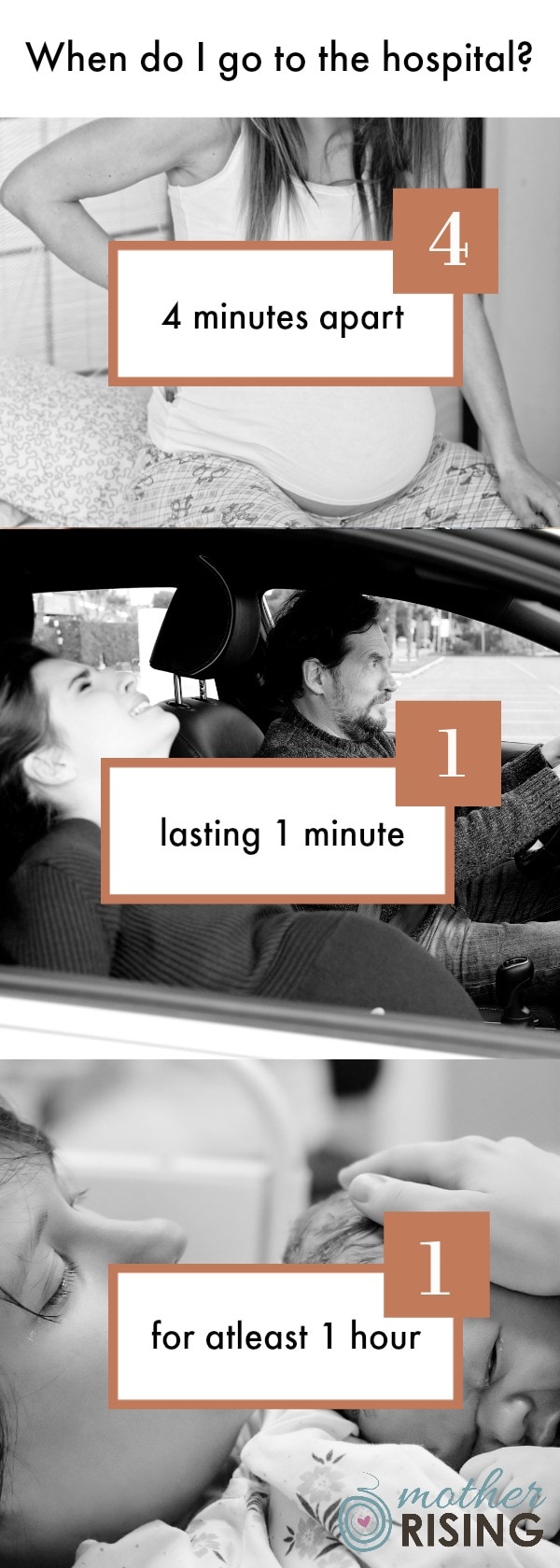
When should you call your midwife to come to your home?
The above advice can be followed in any sort of birth, including a homebirth. Instead of timing it to leave and go to the hospital, that would be the time to call your midwife to come to your home.

When will my water break?
The amniotic sac can break before labor, during labor or during pushing. Very rarely, some babies are born in the amniotic sac. (It’s said to be good luck!)
However, despite what Hollywood says, only around 10% of women experience their water breaking before the onset of labor. In my experience as a doula, the water typically breaks during transition or the pushing stage of labor.
Since a woman has rarely or never experienced this before, when her water breaks, it’s common for her brain to compare it to what she already knows. She knows what it feels like to pee. She also knows what it’s like when her period starts. As quickly as those thoughts come, right behind it is the new realization that this is something different. What she is feeling is her water breaking.
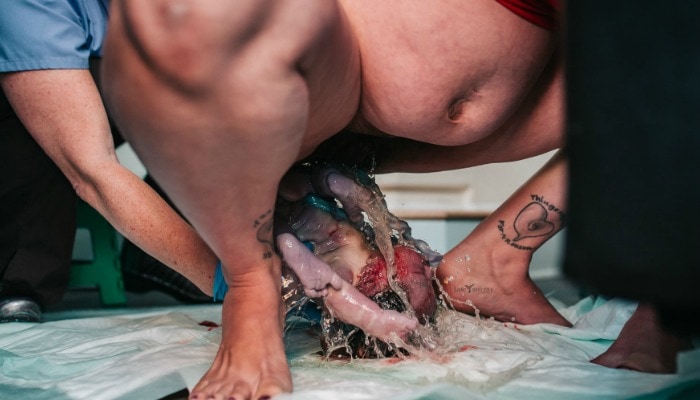
What should I do when my water breaks?
Over the years my answer to this question has changed quite a bit. The best response I can come up with to answer this question is to follow your care provider’s advice.
Many care providers wish you to “come in right away” if your amniotic sac ruptures. Some want you to “come in within a couple hours”.
Every birth, every mom, every care provider is different. Have a conversation with your care provider during a prenatal appointment to see what they recommended for you and your baby.
Sum it Up: Active Labor
In conclusion, active labor is the part of the first stage of labor that comes after early labor, but before transition. Parents spend most of their time in active labor, and things typically go much quicker after that. Active labor is when most parents head to the hospital and the cervix is dilated to around 6 cm.
There are many non-pharmacological ways to cope through active labor inducing staying in the present moment, noticing the breath, and being upright and changing positions.
Talk with your care provider about what makes most sense for you, this pregnancy, and this baby. You can do it!
Next Up: Transition
After active labor comes transition, the final part of the first stage of labor and what happens right before pushing. Head on over here to learn all about transition, but also ways to get through transition without an epidural. (Make sure to read the comments!)


Gabby
Thursday 15th of November 2018
During my recent all natural labor and delivery, I KEPT coming back to your posts. During early labor I did not obsess over timing contractions (as I thought I would). Asbthe contractions became more “intense” and FELT longer and closer together, I gradually made the decision to leave for the hospital. At that point I didn’t even ask my Mom (my designated contraction timer) how far apart they were. I just KNEW it was time to go.